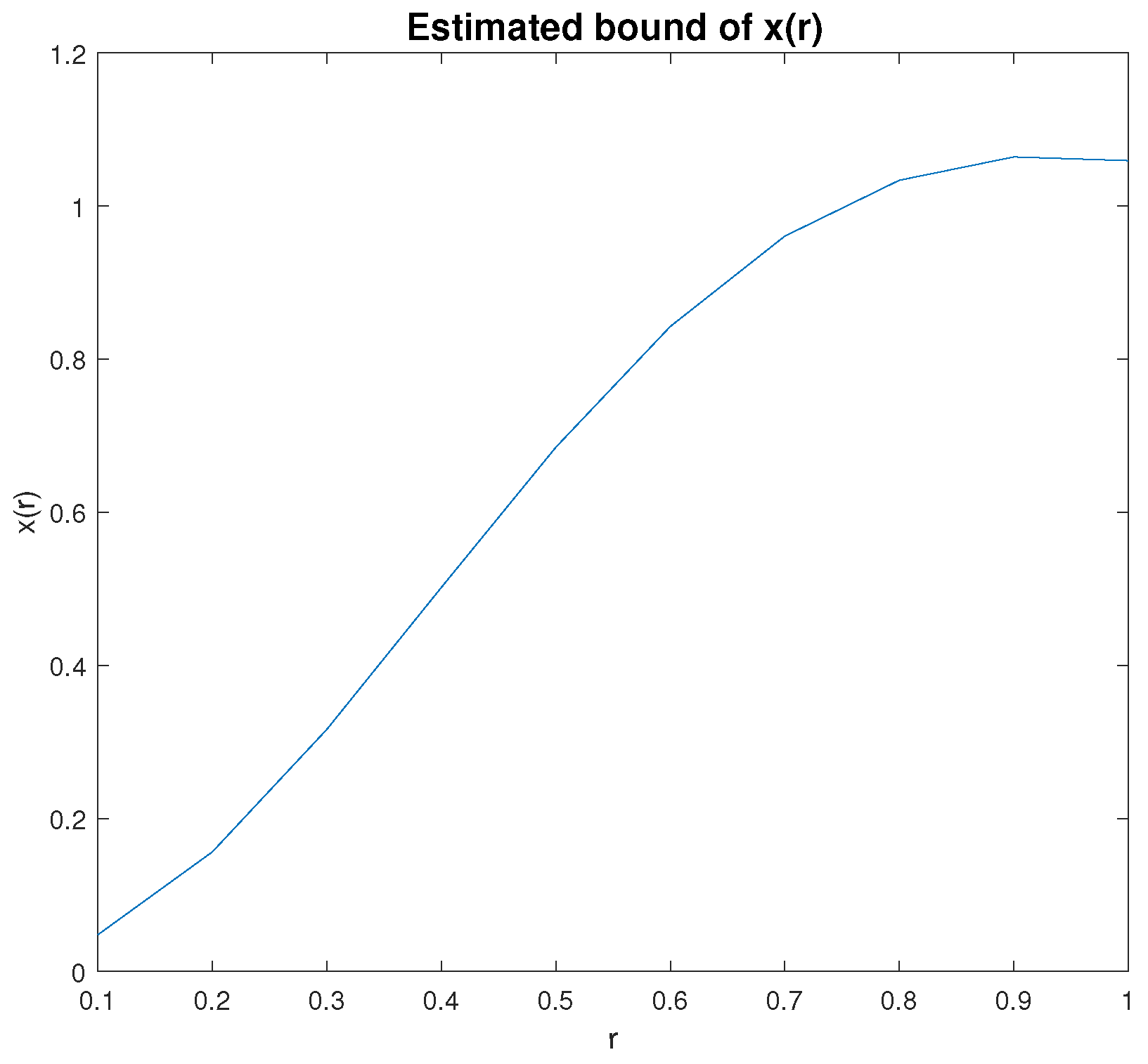New Nonlinear Retarded Integral Inequalities and Their Applications to Nonlinear Retarded Integro-Differential Equations
Abstract
1. Introduction
2. Preliminaries
3. Results on Retarded Integral Inequalities
- (1).
- If we take (a constant) and , then Theorem 1 is converted into inequality (6) [12].
- (2).
- When we suppose (a constant), , and , then inequality (9) [3] becomes the corollary of Theorem 1.
- (3).
- If we put (a constant), , , , and , then we obtain the Gronwall–Bellman inequality [9] given in (3).
- (4).
- When we put (a constant), , , and , then Theorem 1 is reduced to inequality (8) [13].
4. Existence and Boundedness of Solution
5. Conclusions
Author Contributions
Funding
Data Availability Statement
Acknowledgments
Conflicts of Interest
References
- Bainov, D.; Simeonov, P. Integral Inequalities and Applications; Kluwer Academic: Dordrecht, The Netherlands, 1992. [Google Scholar]
- Hardy, G.H.; Littlewood, J.E.; Polya, G. Inequalities, 2nd ed.; Cambridge University Press: Cambridge, UK, 1952. [Google Scholar]
- Pachpatte, B.G. Inequalities for Differential and Integral Equations; Academic Press: London, UK, 1998. [Google Scholar]
- Boichuk, A.A.; Samoilenko, A.M. Generalized Inverse Operators and Fredholm Boundary Value Problems, 2nd ed.; Walter de Gruyter: Berlin, Germany; Boston, MA, USA, 2016. [Google Scholar]
- Shakoor, A.; Samar, M.; Athar, T.; Saddique, M. Results on retarded nonlinear integral inequalities with mix powers and their applications in delay integro-differential. Ukr. Math. J. 2023, 75, 478–493. [Google Scholar] [CrossRef]
- Sun, Y.; Xu, R. Some weakly singular Volterra integral inequalities with maxima in two variables. J. Inequal. Appl. 2023, 2023, 36. [Google Scholar] [CrossRef]
- Abuelela, W.; El-Deeb, A.A.; Baleanu, D. On Some Generalizations of Integral Inequalities in n Independent Variables and Their Applications. Symmetry 2022, 14, 2257. [Google Scholar] [CrossRef]
- Gronwall, T.H. Note on the derivatives with respect to a parameter of the solutions of a system of differential equations. Ann. Math. 1919, 20, 292–296. [Google Scholar] [CrossRef]
- Bellman, R. The stability of solutions of linear differential equations. Duke Math. J. 1943, 10, 643–647. [Google Scholar] [CrossRef]
- Jiang, F.; Meng, F. Explicit bounds on some new nonlinear integral inequalities with delay. J. Comput. Appl. Math. 2007, 205, 479–486. [Google Scholar] [CrossRef]
- Agarwal, R.P.; Deng, S.; Zheng, W. Generalization of a retarded Gronwall-like inequality and its applications. Appl. Math. Comput. 2005, 165, 599–612. [Google Scholar] [CrossRef]
- Abdeldaim, A.; El-Deeb, A.A. On generalized of certain retarded nonlinear integral inequalities and its applications in retarded integro-differential equations. Appl. Math. Comput. 2015, 256, 375–380. [Google Scholar] [CrossRef]
- Pachpatte, B.G. A note on Gronwall-Bellman inequality. Math. Anal. Appl. 1973, 44, 758–762. [Google Scholar] [CrossRef]
- Abdeldaim, A.; El-Deeb, A.A. On some generalizations of certain retarded nonlinear integral inequalities with iterated integrals and an application in retarded differential equation. J. Egypt. Math. Soc. 2015, 23, 470–475. [Google Scholar] [CrossRef]
- Wang, W.S. Some retarded nonlinear integral inequalities and their applications in retarded differential equations. J. Inequal. Appl. 2012, 2012, 75. [Google Scholar] [CrossRef]
- Abdeldaim, A.; Yakout, M. On some new integral inequalities of Gronwall-Bellman-Pachpatte type. Appl. Math. Comput. 2011, 217, 7887–7899. [Google Scholar] [CrossRef]
- Shakoor, A.; Ali, I.; Azam, M.; Rehman, A.; Iqbal, M.Z. Further Nonlinear Retarded Integral Inequalities for Gronwall-Bellman Type and Their Applications. Iran. J. Sci. Technol. Trans. Sci. 2019, 43, 2559–2568. [Google Scholar] [CrossRef]
- Cheung, W.S. Some new nonlinear inequalities and applications to boundary value problems. Nonlinear Anal. 2006, 64, 2112–2128. [Google Scholar] [CrossRef]
- Shakoor, A.; Ali, I.; Wali, S.; Rehman, A. Some Generalizations of Retarded Nonlinear Integral Inequalities and Its Applications. J. Math. Inequal. 2020, 14, 1223–1235. [Google Scholar] [CrossRef]
- Shakoor, A.; Samar, M.; Wali, S.; Saleem, M. Retarded nonlinear integral inequalities of Gronwall-Bellman-Pachpatte type and their applications. Honam Math. J. 2023, 45, 54–70. [Google Scholar]


Disclaimer/Publisher’s Note: The statements, opinions and data contained in all publications are solely those of the individual author(s) and contributor(s) and not of MDPI and/or the editor(s). MDPI and/or the editor(s) disclaim responsibility for any injury to people or property resulting from any ideas, methods, instructions or products referred to in the content. |
© 2024 by the authors. Licensee MDPI, Basel, Switzerland. This article is an open access article distributed under the terms and conditions of the Creative Commons Attribution (CC BY) license (https://creativecommons.org/licenses/by/4.0/).
Share and Cite
Samar, M.; Zhu, X.; Shakoor, A.; Osman, M. New Nonlinear Retarded Integral Inequalities and Their Applications to Nonlinear Retarded Integro-Differential Equations. Axioms 2024, 13, 356. https://doi.org/10.3390/axioms13060356
Samar M, Zhu X, Shakoor A, Osman M. New Nonlinear Retarded Integral Inequalities and Their Applications to Nonlinear Retarded Integro-Differential Equations. Axioms. 2024; 13(6):356. https://doi.org/10.3390/axioms13060356
Chicago/Turabian StyleSamar, Mahvish, Xinzhong Zhu, Abdul Shakoor, and Mawia Osman. 2024. "New Nonlinear Retarded Integral Inequalities and Their Applications to Nonlinear Retarded Integro-Differential Equations" Axioms 13, no. 6: 356. https://doi.org/10.3390/axioms13060356
APA StyleSamar, M., Zhu, X., Shakoor, A., & Osman, M. (2024). New Nonlinear Retarded Integral Inequalities and Their Applications to Nonlinear Retarded Integro-Differential Equations. Axioms, 13(6), 356. https://doi.org/10.3390/axioms13060356







